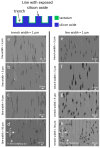Critical Design Parameters of Tantalum-Based Comb Structures to Manipulate Mammalian Cell Morphology
- PMID: 40363602
- PMCID: PMC12072305
- DOI: 10.3390/ma18092099
Critical Design Parameters of Tantalum-Based Comb Structures to Manipulate Mammalian Cell Morphology
Abstract
Mammalian tissues and cells often orient naturally in specific patterns to function effectively. This cellular alignment is influenced by the chemical nature and topographic features of the extracellular matrix. In implants, a range of different materials have been used in vivo. Of those, tantalum and its alloys are promising materials, especially in orthopedic implant applications. Previous studies have demonstrated that nano- and micro-scale surface features, such as symmetric comb structures, can significantly affect cell behavior and alignment. However, patterning need not be restricted to symmetric geometries, and there remains a gap in knowledge regarding how cells respond to asymmetric comb structures, where the widths of the trenches and lines in the comb differ. This study aims to address this gap by examining how Vero cells (cells derived from an African green monkey) respond when applied to tantalum and tantalum/silicon oxide asymmetric comb structures having fixed trench widths of 1 μm and line widths ranging from 3 μm to 50 μm. We also look at the cell responses on inverted patterns, where the line widths were fixed at 1 μm while trench widths varied. The orientation and morphology of the adherent cells were analyzed using fluorescence confocal microscopy and scanning electron microscopy. Our results indicate that the widths of the trenches and lines are important design parameters influencing cell behavior on asymmetric comb structures. Furthermore, the ability to manipulate cell morphology using these structures decreased when parts of the tantalum lines were replaced with silicon oxide.
Keywords: Vero cells; adhesion; mammalian cells; morphology; silicon oxide; tantalum.
Conflict of interest statement
The authors declare no conflicts of interest.
Figures









Similar articles
-
Nanoscale-Textured Tantalum Surfaces for Mammalian Cell Alignment.Micromachines (Basel). 2018 Sep 13;9(9):464. doi: 10.3390/mi9090464. Micromachines (Basel). 2018. PMID: 30424397 Free PMC article.
-
Pattern-Dependent Mammalian Cell (Vero) Morphology on Tantalum/Silicon Oxide 3D Nanocomposites.Materials (Basel). 2018 Jul 28;11(8):1306. doi: 10.3390/ma11081306. Materials (Basel). 2018. PMID: 30060574 Free PMC article.
-
In-Vitro Study of Indium (III) Sulfate-Containing Medium on the Viability and Adhesion Behaviors of Human Dermal Fibroblast on Engineered Surfaces.Materials (Basel). 2023 May 18;16(10):3814. doi: 10.3390/ma16103814. Materials (Basel). 2023. PMID: 37241441 Free PMC article.
-
Development and applications of porous tantalum trabecular metal-enhanced titanium dental implants.Clin Implant Dent Relat Res. 2014 Dec;16(6):817-26. doi: 10.1111/cid.12059. Epub 2013 Mar 25. Clin Implant Dent Relat Res. 2014. PMID: 23527899 Free PMC article. Review.
-
A comprehensive review of biological and materials properties of Tantalum and its alloys.J Biomed Mater Res A. 2022 Jun;110(6):1291-1306. doi: 10.1002/jbm.a.37373. Epub 2022 Feb 13. J Biomed Mater Res A. 2022. PMID: 35156305 Review.
References
Grants and funding
LinkOut - more resources
Full Text Sources
Miscellaneous

